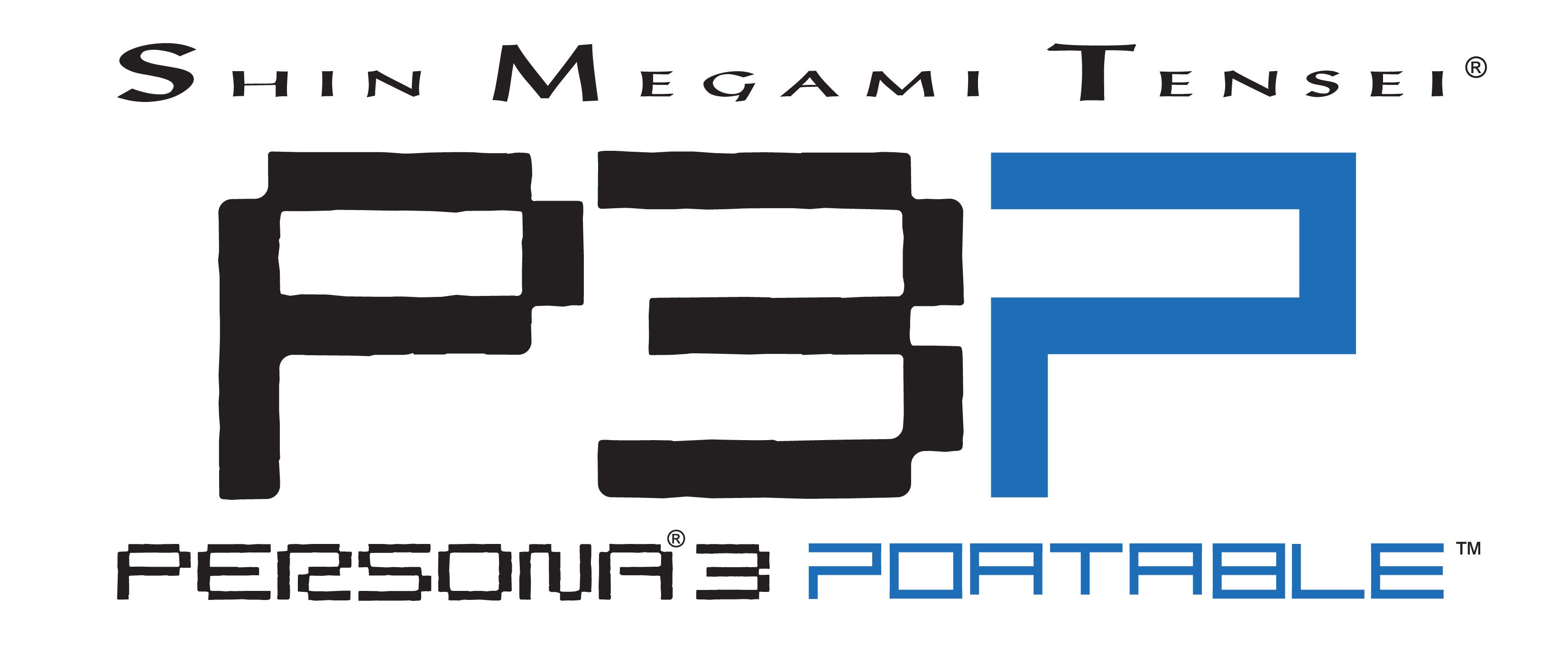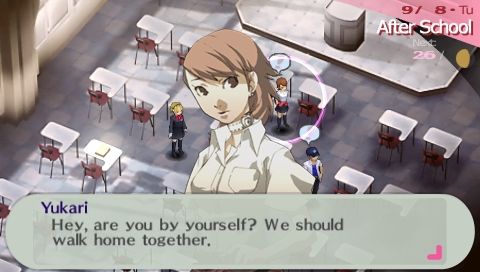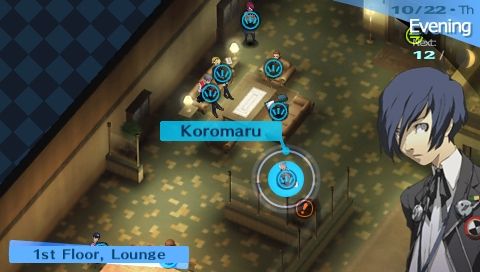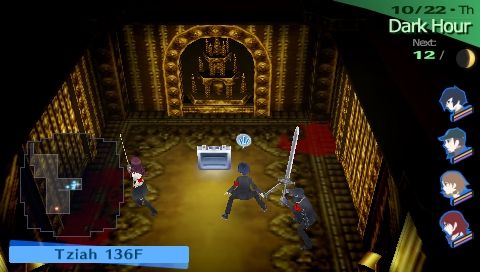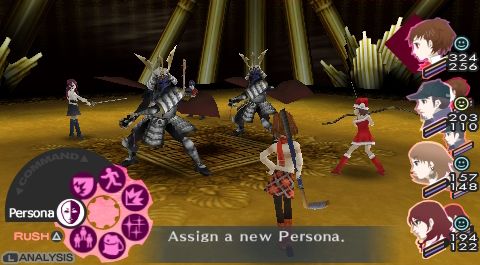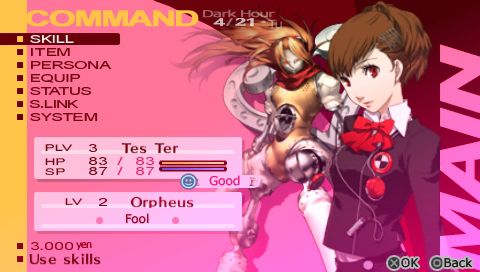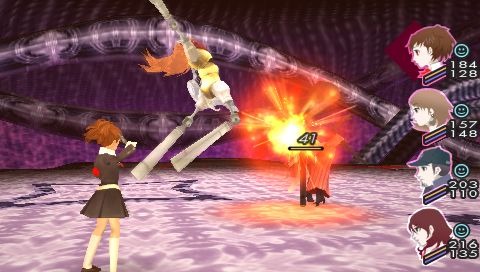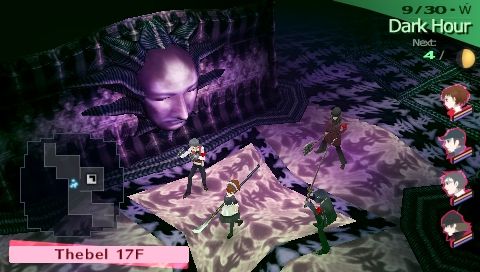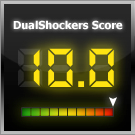Persona 3 was originally released back in 2007, then re-released the following year with an extra add-on story (Persona 3 FES). I played it back then and I played it now, and I won’t lie, I’ve been waiting for this portable iteration for a while, yearning so much jump back into that world.
Persona 3 Portable is not a port, it is a remake. Some things were removed from the original title, such as the anime cut scenes and the ability to move your character around the game world anywhere outside of the dungeons, but so much more was added that I wouldn’t be going out on too long a plank saying this is the definitive version of Persona 3. Throughout this review I’m sure you’ll see why I think the way I do.
The all-important main narrative revolves around a group of high-school students who have what is termed “the potential”. This is a special ability that they have to summon personas. Those with “the potential” also are aware of a “hidden” hour of time that occurs every night at midnight, dubbed the “Dark Hour”. During this hour, everyone without “the potential” turns into coffins and the world transforms. For example, where their school stands during the day, when the “Dark Hour” comes around there is a large tower called Tartarus.
This tower is where the majority of your exploration and battling take place – it is one big dungeon crawl. The whole story is filled with these teenagers trying to figure out what causes the “Dark Hour”, why it happens, what Tartarus is and all sorts of other questions surrounding these mysterious events. There are surprises, twists and turns along the way. In fact, the story is so masterfully crafted that you’re almost subconsciously motivated to move to the next day to find out what new little nuance will be revealed. What the story is not is an in-your-face action love-fest, so if you’re expecting to have huge bits of story dropped in your lap all at once, you will be in for an unpleasant surprise.
Our heroine and her friends all fight with standard weapons, as well as their personas. These are being summoned from the inner depths of your soul by shocking your senses with an Evoker - a gun-shaped device that these teenagers hold to their heads and fire during battle. This disturbing imagery caught some negative attention when the game was initially released. However, this concept both shocked and intrigued me the first time through, enough for me to pay rapt attention to what was going on.
The characters are all believable and “real” – they have real personal problems, real worries, real fears. They’re easy to relate to. In fact, many of the things the main and side characters go through I can personally relate to, as can, I’m sure, anyone who went to high-school. Yet, at the same time, these characters are living our dream. Didn’t you always used to dream of being more than the sum of your parts? Did you dream about being a super-hero, like Batman or Wolverine? We all did at one point, right? While these characters may be living what appears to be ordinary lives during the day, they are actually working to save the world during the “Dark Hour”.
While they removed the anime cut scenes and the free roam around most aspects of the game, replacing them with mostly static backdrops and character portraits for dialog sequences, it still works. The graphic style is amazing and, even with the reduced dynamic nature of the environments, you’re still drawn into the world of Persona 3. It doesn’t hurt that the music is awesome, as well. Various pop-rock tracks fill the background, depending on what location you’re in and the time of day. The audio is spunky when it needs to be, and melancholy when events demand it. Many vocal tracks are included, as well as purely instrumental segments. They all work together amazingly well, which is something you really wouldn’t expect from such an eclectic mix of tunes.
The game progresses from calendar day to calendar day, spanning from March through December, initially. You will live each day through the eyes of your character – either the original male protagonist, or the new female. You’ll make friends with your main party members, as well as other characters throughout your school and all over town. These relationships are referred to as Social Links. By spending time with the people who make up these links, you give yourself more power when creating new personas through fusion. The higher your Social Link rank which corresponds to the persona you want to make, the more experience it will get when you create it, thus leveling it up immediately.
Of course, that would mean there is a direct correlation between your social life during the day and your efforts climbing Tartarus at night, fighting the Shadows valiantly with your persona by your side. While the two parts of the game are somewhat separate, especially in feel and mechanics, they work together to make both equally important. What really drew me to the game initially, though, wasn’t your standard RPG fare like the battle system, dungeon crawl, persona fusion or leveling up. No, it was the relationship-building aspect.
There are quite a few Social Links you can establish with both your party members and other characters within the game world – whether it be that foreign exchange student from France or the older couple who runs a local book store. Some of them you’re directed to pretty openly, while others you need to search out and find on your own. Your character herself has three different stats that you can build up that mostly help you with events during your “normal” daytime life – Charm, Courage and Academics. Sometimes, to establish Social Links, you need to be at a certain level with one of those stats. You can raise those stats by doing various things during the the two blocks of time within the day you have free reign. To raise your Academics, for example, you can study in the school library (during the After School block of time) or at the desk in your room (during the Evening block of time if you don’t go to Tartarus).
Unfortunately there is one big dry spell in being able to build up Social Links that carries over from the original title. While playing through P3P, I was reminded how noticable the lack of available Social Links is during your summer vacation (which begins in-game in August). Typically the characters available to you each day to build Social Links with are standing around school with an “!” above their head in a thought bubble.
However, during summer the only ones available that I can see are a single new party member and the old couple at the strip mall book store. That’s it. Any other relationships you had going with various party members are seemingly put on hold until school starts up again in September. There is one exception to this, in that during the Daytime segment of time you can receive a phone call from one of your Social Links, asking you to hang out. But this rarely, if ever, resulted in a rank up. Contrast this with Persona 4, where most characters you can establish relationships with have two locations to meet them - one at school and one around town. It’s disappointing they didn’t add that feature into P3P.
Sometimes during the day you’re given pop quizzes in class, as well. Some of these questions are to see if you’re paying attention to the dialog directly preceding them, and that is fine. However, some are completely random cultural questions that most people will not know. It is pretty much a crap-shoot whether or not you’ll guess the right answer. All of the questions have a chance to be on your exams, which come around every two to three months. Yes, there are exams in this game, suckers! However, if you miss the questions, there is no effect other than you won’t get the stat boost associated with that particular question (usually Academics or Charm).
In the original version of Persona 3, you’re able to freely walk around school and town during the day, controlling your character. This time around you’re given a static backdrop for each area and a pointer to activate conversations or move from location to location. It is actually much faster to get around this way, and I don’t think it takes away anything from the game overall, but I do miss the exploration aspect of moving your character around freely. Also added is Persona 4’s Square button menu, which brings up a list of places you can go from any given location. You can then select any of them to instantly go there, instead of walking. This is a welcome addition, as well.
Finally, along with going various places to receive stat boosts, Atlus has added in after school jobs that you can participate in, much like in Persona 4. This adds an extra thing to spend your time on and gives you some more Yen to spend in-game, as well (as if you didn’t get enough while exploring Tartarus).
Now, leaving the daytime hours, let’s move on to what happens during the evening. This is when most of your main story events take place, because it is the time period directly preceding the “Dark Hour”. Most nights you end up back at your dorm, having free reign as to what to do. This could include going to the mall, going to Tartarus or going to your room to study or just go to bed early (eventually there is a Social Link or two you can participate in during this block of time, as well).
Choosing to go to Tartarus puts you at the entrance doorway where eventually you can select your party. You can also save and heal from a clock sitting in the room (although it costs you Yen to heal). This is basically your base of operations for your dungeon romp.
Traversing Tartarus is much the same as it was in the original game. This is also the only time in P3P where you can directly control your character as you move through the many blood-spattered corridors, attempting to avoid a sneak attack by a passing Shadow. When you do enter battle, one major thing has changed – you can now control each party member directly like in Persona 4. This is a much welcomed and, in my opinion, needed addition to the game. While it didn’t ruin the game for me the first time around, it was a bit odd leaving the fate of any given battle up to the AI.
The main protagonist has multiple personas at their disposal, each with unique abilities and attributes. You can either find these personas while exploring Tartarus or fuse multiple personas together to make a more powerful companion. There is a chance after each battle that a series of cards will be displayed. These will then be shuffled in front of you and, at the end, you get to choose one. Cards can increase your experience earned from that battle, restore health and mana, give you an item to use or sell or reward you with a new persona.
Part of the fun of battles in P3P is learning enemy weaknesses and exploiting them. Your guide (Mitsuru early on and Fuuka a couple months into the game) has the ability to determine any given mob’s weakness, although it takes a few turns during battle. Once you determine its weakness, it is pretty easy to exploit. Exploiting this weakness is almost needed, because if you don’t, some groups of regular enemies can be quite a handful. When you hit an enemy with an ability or attack they’re weak against, they are knocked down and more vulnerable to attack. When you knock down all mobs on the screen by doing that, you can perform what is called an “All Out Attack”, which shows all available party members jumping into a big pile to beat the ever living crap out of your opponents. It is a fun animation to watch and brings a smile to my face each time.
Other random events during battle are the dual-attacks, in which one party member asks to team up with the protagonist for a combo attack on one enemy, usually resulting in a critical hit (which will also knock the enemy down).
Once you collect a few personas through the random card shuffle at the end of battles, you can take them to Igor in the Velvet Room to fuse them together to create more powerful ones. You can access the Velvet Room during the After School time block at the mall or during the “Dark Hour” just outside the entrance to Tartarus. Here is where your Social Link levels come into play. If you create a persona that is attached to one of your established Social Links, the persona will immediately gain experience based on the rank of said Social Link. More experience means the persona levels up immediately, possibly learning new abilities or skills that the “base model” wouldn’t necessarily have from the start. This just gives you that much extra boost in battle, knowing you have a leveled up persona without actually doing much.
Also in the Velvet Room is Igor’s assistant. His assistant helps you with persona fusion, as well as issues out various quests that you can perform throughout the game. There’s also a persona compendium you have access to. If you register your personas there, even if you lose them through fusion, you can go back and pull them out, for a price.
Another new series of side-quests unique to P3P are the missing persons, which start happening a couple months into the game. These are people lost in Tartarus that you must save before a certain in-game day. This adds some playtime to the title, but it doesn’t necessarily get by without feeling they were put there just to artificially inflate the experience. I enjoyed finding and helping these people, because it fits well into the story. However, sometimes (not always), the missing person is nowhere near a point you can teleport into Tartarus. For example, the first one I had to find was between floors 44 and 47. That’s all well and good, except the closest point I could teleport into was on floor 25. So I had to traverse nearly 20 floors, mostly filled with too-weak-to-bother-with mobs, just to get to floor 44 to start looking for them. A feature that would transport you right to the first floor they were suspected to be would have been nice. Sometimes, however, the teleport point is much closer and you only have to traverse one or two floors to get to their destination.
Like I said near the beginning, if you’re looking for a fast-paced RPG, this is not it, but that isn’t a fault, it is a plus. The story is revealed over time on certain dates. There will be times when you will spend an entire week not doing anything besides building Social Links, just as there will be times when you’ll go into Tartarus several nights in a row. This is, for the most part, up to the discretion of the player, although certain points typically have to be reached before certain dates, especially for side-quests. There are also times when you're prevented from going to Tartarus in the evening, as well as mandatory story-related missions on certain predetermined days.
Overall, both the daytime and “Dark Hour” parts of the game work together to create a rather immersing, unique experience. At first they seem separate, but the more you play the more you realize both parts of the game are really intertwined and rely on the other to create that immersive feeling.
Finally, I would be remiss if I didn’t talk about how well this game works on the PSP, since there is some migration needed when bringing a console game over. How well does it work? Typically, pretty well. There are three static save points throughout the game, always in the same spots, one for each time of day. There is one in your classroom for the After School segment of time, one in the dorm lobby for the Evening segment and one outside the entrance to Tartarus for the “Dark Hour” events. For the most part, no more than a few minutes of real time passes before you have access to either one of these, so the game really lends itself to portability. You do have to be wary, though, that there are times when it could take a while to get through a particular story segment. The first of such was a ways into the game, but I went for about 45 minutes without being able to save. The PSP’s “Standby” feature is nice, but I’m always worried that the system will restart or the battery will completely run dry while it is in standby (which has happened to me before).
Needless to say, I think P3P translates really well to the portable platform. All the additions to the game – especially the female protagonist character, which comes with a lot of new Social Link opportunities and reworked dialog for various story segments – far outweigh anything that had to be removed, for whatever reason. With the improvements to game play added from Persona 4, we see a huge boost to accessibility and functionality. The look and feel of Persona 3 is still there in the portable iteration and it is still a must play for any gamer, especially if you’re a fan of RPGs. The only thing I was wary of was that I knew how the story would end, since I had played the PS2 version years ago. This ended up not being a problem because I'm a huge fan of the thought that the journey is more important than the destination.
To explain a bit, I played through P3P as the female protagonist this time around, and the interactions with various party members and pre-existing Social Links felt fresh and new. I'm so glad they just didn't do a palette swap between the male and female artwork, or just leave the change at having pink menus instead of blue. That would have been worthless.
What Atlus did do, however, is make the world and characters react to the gender of the protagonist, and that is awesome. There are new Social Links thrown in just for her, characters react differently and bring up new topics, new responses and new issues. Not to mention that the artwork for her is pretty sweet - I was completely enamored with her the entire time. That makes me feel dirty, but I said it.
Also of special note is the fact that there are a couple cameos thrown in from Persona 4, most notably Yukiko Amagi and her family's inn, which you stay at for a night during a special event in the summer. Finally, whether this was in the original or not I can't remember, but Cylon Tea is an item, and its text reads "There are 12 varieties." Kudos, Atlus, I love Battlestar Galactica and tossing in a nod to the show is quite awesome.
Ultimately, this game exudes charm, contains believable characters that you really start to care about and spins a wild, wonderful and uncharacteristically dark story that just begs for you to take the next step in unraveling. It may be a bit too "visual novel" for some, but when it is all said and done, it reaches into us the same way more popular, mainstream RPGs like Mass Effect do - it gives us choices, relationships to pursue and characters to get to know and feel for, all the while maintaining its solid JRPG foundation that fans of the genre will know and love. In fact, it has a lot more in common with what Western RPGs are trying to do lately than you might think, and that is a good thing.
I applaud Atlus for bringing this remake to the PSP and hope down the line we’re able to see an enhanced version of Persona 4 available on the handheld, as well. (Hint, hint!) The $40 price tag is definitely worth it for the amount of content here – you’ll be spending upwards or 60 hours, minimum, just on the main story alone, and there is so much more to do. This is a great experience for anyone who owns a PSP. The few minor issues I have with P3P are nothing compared to how awesome this game is overall. Go get it!
-
Game: Persona 3 Portable
- Platform Reviewed: PSP
- Release Date: Available Now
- MSRP: $39.99
- Developer: Atlus
- Publisher: Atlus
- Review Copy Info: A download code for this title was provided to DualShockers, Inc. by the publisher for purposes of this review.
Persona 3
- Franchise
- Persona
- Platform(s)
- PS3 , PS2 , PSP
- Released
- July 13, 2006
- Developer(s)
- Atlus
- Publisher(s)
- Atlus , THQ , Ghostlight , Koei Tecmo
- Genre(s)
- JRPG
- ESRB
- M for Mature: Blood, Language, Partial Nudity, Violence

